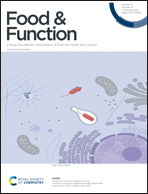Hypoglycemic effect of the polysaccharides from Astragalus membranaceus on type 2 diabetic mice based on the “gut microbiota–mucosal barrier”†
Abstract
Astragalus membranaceus polysaccharides (APP), the main active constituent, possess numerous bioactivities. In this research, a type 2 diabetes mellitus (T2DM) mouse model was combined with streptozotocin to study the hypoglycemic effect and mechanism of APP. The results showed that APP improved glycolipid metabolism disorders, inflammation and oxidative stress levels, and organ injury in T2DM mice. Furthermore, the APP could protect the intestinal barrier by suppressing intestinal inflammation and oxidative stress levels, and strongly inhibited the potential intestinal pathogen Shigella with a reduction rate of 88.92%, and promoted the growth of beneficial bacteria Allobaculum and Lactobacillus by 11.72% and 30.70%, respectively. In addition, the antibiotic test indicated that the APP could repair intestinal barrier damage by remodeling some specific gut microbiota which may be their hypoglycemic mechanism. The results provide a theoretical basis for the development of APP as a novel prebiotic in functional food for diabetes.



 Please wait while we load your content...
Please wait while we load your content...